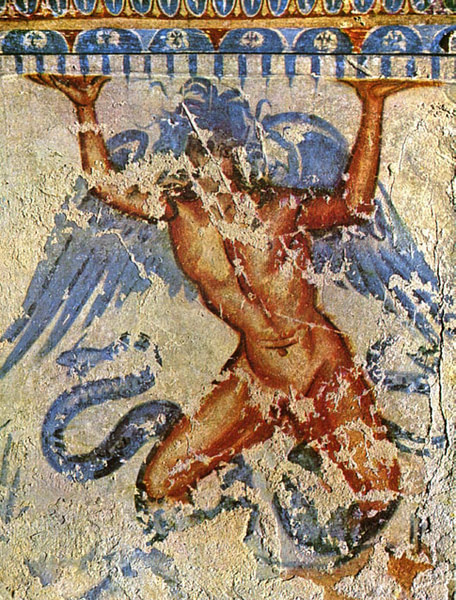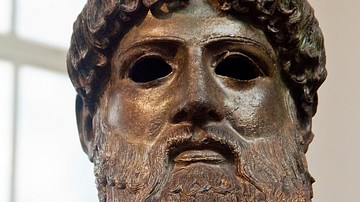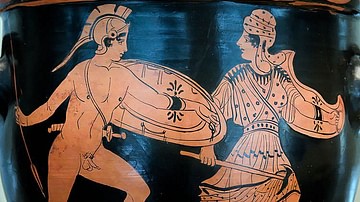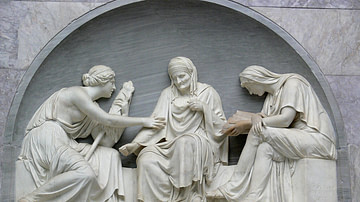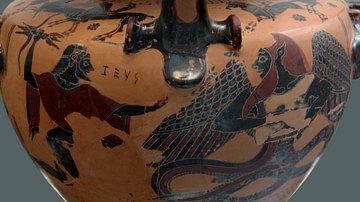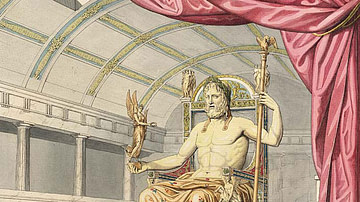
Typhon (also Typheus) is the largest and most dreadful monster in Greek mythology. He was tall, with a brutish face, and had wings, countless snakeheads in place of hands, and a lower body made up of coiled serpents. His eyes flashed fire, and fiery rocks fell from his mouth.
Typhon was the son of Gaia (the Earth) and Tartarus (the Infernal Regions), although he is also mentioned as being the son of Hera in the Homeric Hymn to Apollo. He joined in love with Echidna, a half-woman, half-snake creature, and together they had many fierce children. The most famous myth associated with Typhon is his battle with Zeus and the Olympian gods, as he sought to rule over gods and mortals. Typhon is also associated with Set from ancient Egyptian mythology and other Near Eastern myths.
Birth & Family
In revenge for the destruction of her children (the Giants), Gaia lay with Tartarus and gave birth to Typhon, the biggest monster in Greek mythology, in a cave in Cilicia. In the Homeric Hymn to Apollo, the birth of Typhon is very different. He was the son of Hera, who was angry that Zeus had given birth to Athena without any involvement from her. Hera begged that Gaia, Uranus, and the Titans would give her a son who was mightier than Zeus. She became pregnant after she beat the Earth with her hand. She stayed in her temples and accepted offerings to her. After many months had passed, she gave birth to the cruel and dreaded Typhon. Hera gave Typhon to the dragon Python to be brought up, and they both wreaked havoc among the mortals.
Typhon fell in love with Echidna, a half-woman, half-snake creature, who was both beautiful and terrible to look at, and together they had some of the most fearsome monsters in Greek mythology.
First, Orthos the dog of Geryon, and next,
Unspeakable Cerberus, who eats raw flesh,
The bronze-voiced hound of Hades, shameless, strong
With fifty heads. And then again she bore
The Lernaean Hydra, skilled in wrong, the one
The goddess white-armed Hera raised, who was
Immensely angry with great Heracles.
Description & Characteristics
In his Theogony, Hesiod (c. 700 BCE) calls Typhon "proud" and "terrible." He was violent, powerful and possessed immense strength. Ancient writers describe Typhon in similar ways, with Apollodorus (c. 180 BCE) stating that:
Down to his thighs he was human in form, but of such
Immense size that he rose higher than all the mountains
and often even scraped the stars with his head.
With arms outstretched, he could reach the west on one side
and the east on the other; and from his arms there sprang
a hundred dragons' heads. Below his thighs, he had
massive coils of vipers, which, when they were fully
extended, reached right up to his head and emitted violent hisses.
He had wings all over his body, and filthy hair springing from his
head and cheeks floated around him in the wind,
and fire flashed from his eyes.(Apollodorus, The Library of Greek Mythology, 1.6.4-14).
According to the Greek tragedy playwright Aeschylus (c. 525 to c. 456 BCE), Typhon had a hundred heads, and his eyes burned in a fiery glare. He was able to withstand the power of the gods. In his Dionysiaca, the Greek poet Nonnus (c. 5th century CE), describes Typhon as a tangled mass of snakes with snake feet and hair. From his hair and mouth spat out poison. Nonnus also gives Typhon 200 hands and mentions that the heads of Typhon were made up of all different animals, including wolves, lions, boars and bears.
Typhon's Revolt
The last battle in the Olympians' fight for superiority was Typhon's revolt against them (referred to as the Typhonomachy). Like the Titans and Giants before him, Typhon wanted to rule the heavens. He threw rocks that were on fire up to heaven while hissing and screaming his battle cry. Fire emerged from his mouth like a flowing river. He was such a menacing sight that the Olympian gods immediately fled to Egypt in terror. Typhon pursued them, causing the gods to transform into animals to try and lose him for good. Zeus was said to have transformed into a ram, Apollo into a crow, Dionysos into a goat, Artemis transformed into a cat, Hera into a white cow, Aphrodite into a fish, and Hermes into an ibis (although the animals sometimes differ depending on the source).
Zeus threw thunderbolts at him from a distance, and as Typhon got closer, he stabbed him with an adamantine sickle and chased him. Zeus pursued him to Mount Casion (a mountain range near Syria), where he saw that Typhon was seriously injured. Typhon and Zeus engaged in hand-to-hand combat, with Zeus believing that he could easily kill a weakened Typhon. However, Zeus underestimated Typhon's strength, and before he knew it, Typhon had trapped Zeus in his coils, snatched the sickle from him and slashed the tendons in his hands and feet. Typhon carried Zeus through the sea to the Corycian Cave (near Delphi). Zeus' tendons were hidden in a bear's fur, and Typhon made the she-dragon Delphyne (half-woman, half-monster) guard them. Hermes and Aigipan (rustic spirit) stole the tendons under the nose of Delphyne and put them back into Zeus without being caught. After Zeus had regained his strength, he left the heavens on a chariot with his thunderbolts and continued chasing after Typhon. He found him on Mount Nysa, where Typhon had met the Fates and been tricked by them. They offered him a taste of the ephemeral fruits, promising they would give Typhon extra strength if he consumed them.

Once he realised that Zeus was in pursuit of him again, Typhon escaped to Thrace and battled Zeus near Mount Haimos. He lifted up mountains and hurled them at Zeus. Zeus responded by striking him with thunderbolts. Blood began streaming from Typhon's body and was absorbed by the mountain.
Imprisonment
As Typhon prepared to retreat across the Sicilian Sea, Zeus threw Mount Etna at him and trapped Typhon underneath, ending the battle. To this day, every time Mount Etna erupts, it is said to be caused by the fire in Typhon's eyes or the fiery rocks that flow from his mouth.
But at him came the unsleeping bolt of Zeus,
the sky-dropped thunderclap all wreathed in flame,
and knocked him down from his high-hearted boasts.
The blow went deep into his heart and mind;
his strength was lightning-seared, reduced to ash;
and now he lies, a useless, sprawling mass,
crushed beneath the base of mighty Aetna,
beside the straits of the Messinian sea.
Hephaestus sits there, on the highest ridges,
and smites hot iron. Streams of fire will burst forth,
devouring with the jaws of savage beasts
the spreading fields of Sicily fair in fruit-
such is the bile that Typho will set boiling,
with hot blasts of a deadly fire-storm-
Despite the bolts of Zeus that cindered him.(Aeschylus, Prometheusus Bound, 360-375).
Most ancient authors believed that Typhon was trapped in Tartarus, however, according to Hesiod and Homer (c. 750 BCE), instead of Tartarus, Typhon was imprisoned underneath the land of the Arimoi (a mythical tribe of people). His lover, Echidna, was also trapped there with him.
Typhon & the Near East
As early as the days of Hecataeus of Miletus (c. 550 to c. 476 BCE), some ancient writers, notably the Greek historian Herodotus (c. 484 to 425/413 BCE), believed that there was a link between Typhon and the ancient Egyptian god Seth (Set in ancient Egyptian mythology). In his Histories, Herodotus states that ancient Egypt was once ruled by gods who lived alongside humankind on Earth. The last of the great gods was Horus, who was Apollo's equivalent. Horus was the one who had banished Typhon (Seth).
He also speaks of an island called Chemmis, which floats. According to Herodotus, the Egyptians believed it floats because Leto, one of the oldest deities, welcomed Apollo (Horus) and saved him from Typhon, who had gone searching for the gods in Egypt. She hid Apollo in the island, which made it float. Herodotus mentions a Lake Serbonis (Serbonian Marsh), which he says is where Typhon is hidden and which the Egyptians call "Typhon's breathing hole."
There were even some similarities between the myth of Typhon and the Mesopotamian god Ninurta which can be found in the ancient Sumerian poem Lugal-e ((also known as The Exploits of Ninurta) where Azag-Labbu, the hissing sea-monster challenges the throne of Ninurta, who fights back with floods and fierce winds. There are also similarities between the story of Typhon and the Akkadian epic Enuma Elish, in which Marduk, the patron god of Babylon, uses strong winds to fight against the sea goddess Tiamat.
In the Ancient World
In the ancient world, the story of Typhon was believed to have explained the actual event of the volcanic eruption on the island of Santorini in Greece; after the volcano erupted, people fled from the island, just as the gods ran away from Typhon. Some writers, such as Strabo (c. 63 BCE to 24 CE), believed that the volcanic activity in Italy could be explained by the presence of Typhon being trapped underneath the Earth.
In his Description of Greece, Pausanias (115 to c. 180 CE) says that in Laconia, there were sculptures of Typhon and Echidna near the throne of the Laconian king.


